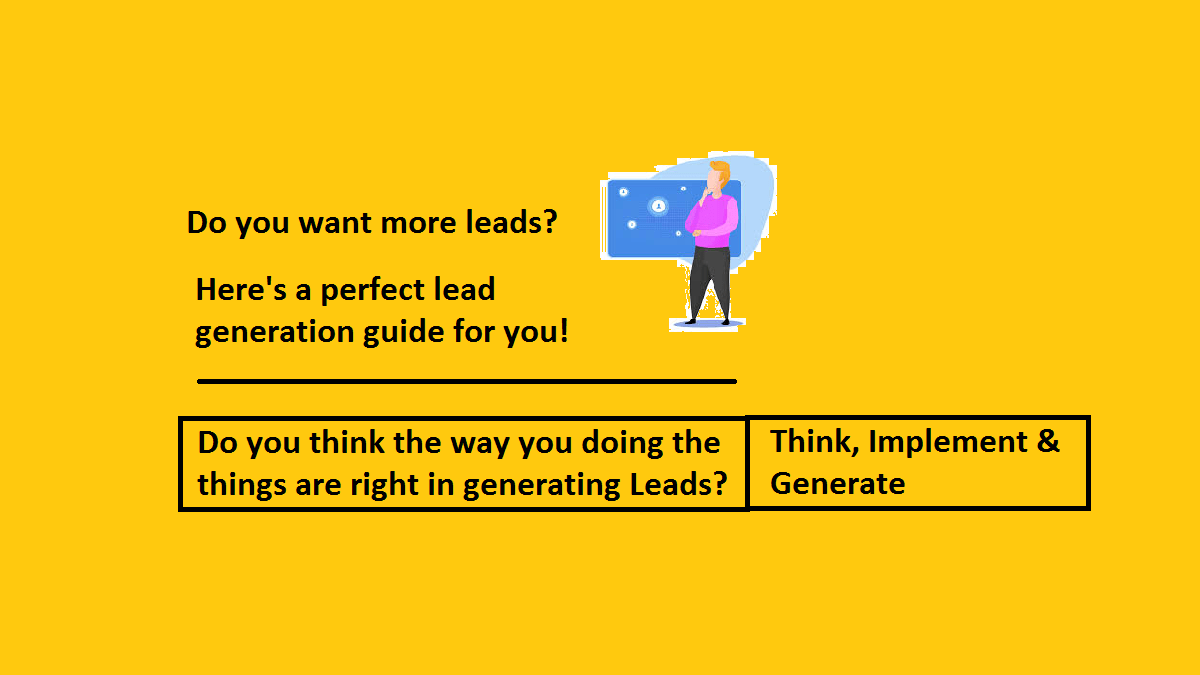Broadly speaking, lead generation can play a critical role in growing your B2B enterprise It can be your key to cut through the noise, build a lingering relationship with consumers, as well as influence the overall purchasing process. However, the most significant challenge could be getting it done correctly. At least this is what 61% of marketers across the length and breadth of the planet has to say about it. So if you do want to get it done, a little bit of help might work great for you.
Who Is A Lead?
A lead can be anyone who is interested in the services or products that your enterprise has to offer. However, a lead might not be ready to avail of your services right at this point in time. Leads are not necessarily prospects. A lead is just a probable client who might want to partner with you in the future.
What is lead generation?
It is the process of engaging, as well as attracting your potential customers. With Lead generation, you start giving different information about your products and services. It can be the very first step to build a strengthening relationship with a prospective client. A little bit of a sample study speaks about the importance of lead generation in the business. This is because, without proper lead generation, almost 90% of B2B sales are likely to close within a month, while 10% takes about a year.
The lead generation funnel
On the surface, it seems that interested buyers are likely to take a random advance while buying anything. However, in reality, there is a process to influence your buyer’s decision. The conception of lead generation funnel helps them to conceive the whole process mentally. This helps in persuading a faster purchase. A well-identified funnel can help a company owner to select potential customers, cater to their needs, convince them, and finally as well as entrust them to the sales team.

Basically, a lead generation funnels stand for the journey that any person goes through right from the moment they share their information to a company. The journey ends after he finally makes a buy.
- It is important because a majority of competent leads are not likely to purchase after the first contact. Your lead funnel can chalk out a roadmap to take them there.
- The entire plan is represented as a funnel. This is because, in each stage of the roadmap, you will see fewer people sticking to the criteria of being your client.
- Your content in the funnel is crucial for lead generation. You can make it through tools like competent case studies, blogs, or anything practical.
- Use your content strategically to identify whether any of the leads is in the process of buying. You can then entreat them with specially customized content that fits their unique needs.
- Each piece of engaging content would propel your lead to progress through your company funnel.
Each aspect of the funnel has some uniqueness. To get the best results from your lead generating funnel, you might want to choose different content at every step.
To begin with
1. The top of the funnel or the TOFU stage is the preliminary phase, where your audiences are likely to visit your company website casually. During this stage, your company is going to focus more on the possible customers. The ideal content to engage more and more fresh audiences could be:
- Blogs
- Social media posts
- Guides
- Videos
- Podcasts
2. The middle of the funnel or the MOFU phase is the time when visitors would gradually convert into leads. It is the time when your enterprise can build trust in the business relationship. The content s during this phase can be more of ‘direct’ types, such as:
- White papers
- E-books
- Webinars
- Tools
- Newsletters
In this phase, your content would depend on your target audience, resources, as well as offering.
3. Finally, at the bottom of the funnel or BOFU stage, your leads have converted to prospects. They have all the probable solutions to their issues that relate to your company’s service or products. It is time to send them to the selling team. The most potent contents during this phase could be:
- Comparison charts
- Case studies
- Demos
- FAQs
- Reviews
How to generate leads?
After going through the basics of lead generation plan, it is time to look into the process of generating leads.
It might not be a cakewalk, to begin with. Then again, you are not alone in this battle. You may find it unbelievable, but almost 63% of marketers take the lead and traffic generation to be their biggest challenge in sales. You might find it even more daunting that almost 80% of marketers believe that their lead generation efforts have been partially effective what most of the marketing professionals miss out on that it needs not to be in this way. In fact, you can work effectively for a lead generation plan with five necessary steps.
They include:
- Understanding the persona of your purchaser – you can make it by gathering qualitative and quantitative information from your existing, as well as targeted customers.
- Creating intriguing contents that emphasize on your products’ value along with their latent return on investment or ROI
- Targeting and attracting the perfect audiences
- Capturing necessary information
- Qualifying the leads
Lead generation marketing strategies
Your strategy would aim at enhancing the quality, as well as the number of visitors who come from organic search results.
1. SEO or search engine optimization is crucial for optimal lead generation. This is because; it helps to invite a considerable number of visitors. They can reach the final level of your lead generation funnel.
The small steps to perfect SEO strategy include:
- Defining the most competent keywords for your business
- Create engaging content and then optimizing it. Tools like e-books and webinars can double up as a ‘lead magnet’ and support the visitor.
2. Advertising on Linkedin is another potent tool for lead generation. It really comes handy to mobilize customers who can be the right decision-makers and have some authority in the process of buying. The user data that you get from there assists in targeting the buyer persona. Also, a regular campaign on this social media platform can get you the desired results.
Before starting an advertisement campaign in LinkedIn, make sure that you define various objectives like:
- Frequent website visits
- Website conversations
- Lead generation
3. Co-Marketing also aims at reinforcing an authentic relationship with different companies. Such enterprises might not be your direct competitors. Yet, they would not mind sharing your visitors. For example, if you deal with sales software enterprises, then you can consider co-marketing with that sells human resource software.
4. This is how you can influence the expertise of each other and create better content. Consequently, you get more audiences.
5. You can also try promoting contents from the peers in your business, or ‘borrow’ content ideas from others. This especially comes handy when you need to improve the content of any particular portion of your funnel.
Also read: 8 Powerful Marketing Strategy for Startups to be No.1 in 2020
How to capture leads?
Even if you believe that you have created the best piece of content for your audiences, you might not generate enough leads. To make it, you have to get leads to sharing their personal information with your company. There was a time when people would voluntarily participate in random form-filling activities. However, with more people losing interest in them, gathering information on the leads has become trickier than before.
While there might be no solution to check this issue, changing your way of asking for information might help. It can positively impact on the rate of lead conversation, as well. You can make it in different ways. For example:
- Create Email capture forms – Engaging forms with apt content helps visitors to connect with your company. An email-capture form having wisely-used pop-ups can also be the way to go.
- Use tools for site chats – They are an easy and reliable way to clarify the potential customers of their doubts and questions. This will heavily slash down on the rate of friction and drop out in your company’s lead generation funnel. In fact, most of the modern-day entrepreneurs recommend site chat to stay connected with their followers and patrons.
- Utilize Website visitor identification – You can use it to identify your audiences, even if they do not contribute to the lead capture forms of your company. Different software helps you identify visitors. It helps you to zero in on the leads that have shown interest in your enterprise.
How to qualify leads?
After capturing leads, you have to run the extra mile to ‘qualify’ them. Qualification of leads is an essential step to generate leads. This is that part of your strategy that leads to a winning lead generation. It is a part of a plan that helps you identify the quality leads.
Focusing on your sales and marketing tactics on potential leads in a crucial part of any deal. A sample study shows that almost 67% of unsuccessful sales occur for qualifying leads improperly. Also, about 61% of B2B marketers send all their leads to the sales team directly, thus resulting in unsuccessful deals.
It can be done pursuing a three-step process that involves:
- Defining the model lead
- Gathering information on them
- ‘Scoring’ the leads that bring about sales for diverse segments of the audience.
Final thoughts
The whole process of generating quality leads can be intimidating. In fact, it seems to be a common headache among every B2B marketer. So here is a summary of the entire process to help you get started.
- Identify your funnel, understand your prospective clients, and create the right content for all. This will make way for a rock-solid foundation of your lead generation.
- Next, concentrate on driving the traffic you target, get information on your lead, and qualify prospects for the sales team.
Last but never the least, remember that it is an ever-going process and needs to be continuously improved. It takes time and constant practical effort to comprehend what would work correctly for your customers, as well as for your sales team. Once you get it, you can start driving perfect leads at larger volumes.




